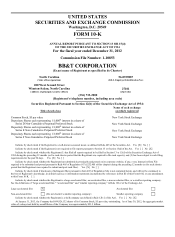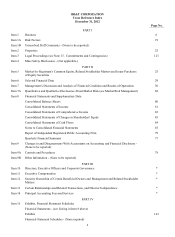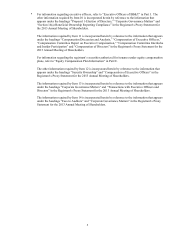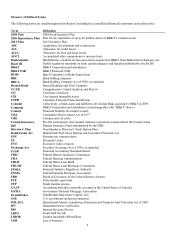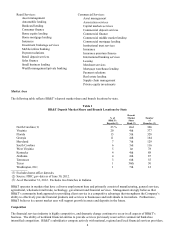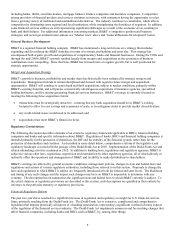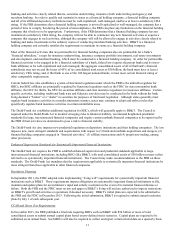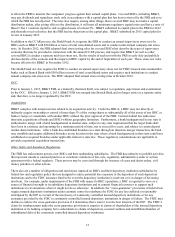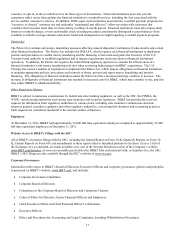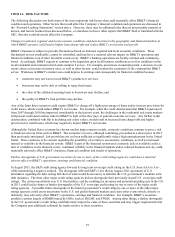BB&T 2012 Annual Report Download - page 32
Download and view the complete annual report
Please find page 32 of the 2012 BB&T annual report below. You can navigate through the pages in the report by either clicking on the pages listed below, or by using the keyword search tool below to find specific information within the annual report.
10
Requiring regulation and oversight of large, systemically important financial institutions by establishing an
interagency council on systemic risk and implementation of heightened prudential standards and regulation by the
FRB for systemically important financial institutions (including nonbank financial companies), as well as the
implementation of the FDIC resolution procedures for liquidation of large financial companies to avoid market
disruption;
applying the same leverage and risk-based capital requirements that apply to insured depository institutions to most
BHCs, savings and loan holding companies and systemically important nonbank financial companies;
limiting the FRB’ s emergency authority to lend to nondepository institutions to facilities with broad-based eligibility,
and authorizing the FDIC to establish an emergency financial stabilization fund for solvent depository institutions and
their holding companies, subject to the approval of Congress, the Secretary of the U.S. Treasury and the FRB;
centralizing responsibility for consumer financial protection by creating a new independent agency, the CFPB, with
responsibility for implementing, enforcing and examining compliance with federal consumer financial laws;
creating regimes for regulation of over-the-counter derivatives and non-admitted property and casualty insurers and
reinsurers;
requiring any interchange transaction fee charged for a debit transaction be “reasonable” and proportional to the cost
incurred by the issuer for the transaction, with new regulations that establish such fee standards, eliminate exclusivity
arrangements between issuers and networks for debit card transactions and limit restrictions on merchant discounting
for use of certain payment forms and minimum or maximum amount thresholds as a condition for acceptance of credit
cards;
transferring the functions of the OTS relating to federal savings associations, including rulemaking authority, to the
OCC;
implementing regulation of hedge fund and private equity advisers by requiring such advisers to register with the SEC;
providing for the implementation of certain corporate governance provisions for all public companies concerning
executive compensation;
increasing the FDIC’ s deposit insurance limits permanently to $250,000 for non-transaction accounts and changing the
assessment base as well as increasing the reserve ratio for the DIF to ensure the future strength of the DIF; and
reforming regulation of credit rating agencies.
Many of the provisions of the Dodd-Frank Act are subject to further rulemaking, guidance and interpretation by the
applicable federal regulators. BB&T will continue to evaluate the impact of any new regulations so promulgated, including
changes in regulatory costs and fees, modifications to consumer products or disclosures required by the CFPB and the
requirements of the enhanced supervision provisions, among others.
As a BHC and a financial holding company under federal law, BB&T is subject to regulation under the BHCA and the
examination and reporting requirements of the FRB. Branch Bank, a state-chartered commercial bank, is subject to
regulation, supervision and examination by the North Carolina Commissioner of Banks and the FDIC.
State and federal law govern the activities in which Branch Bank engages, the investments it makes and the aggregate amount
of loans that may be granted to one borrower. Various consumer and compliance laws and regulations also affect its
operations. Branch Bank also is affected by the actions of the FRB as it attempts to control the monetary supply and credit
availability in order to influence the economy.
In addition to federal and state banking laws and regulations, BB&T and certain of its subsidiaries and affiliates, including
those that engage in securities underwriting, dealing, brokerage, investment advisory and insurance activities, are subject to
other federal and state laws and regulations, and supervision and examination by other state and federal regulatory agencies
and other regulatory authorities, including the SEC, FINRA, NYSE, and various state insurance and securities regulators.
Financial Holding Company Regulation
Under current federal law, a BHC, such as BB&T, may elect to become a financial holding company, which allows the
holding company to offer customers virtually any type of service that is financial in nature or incidental thereto, including



